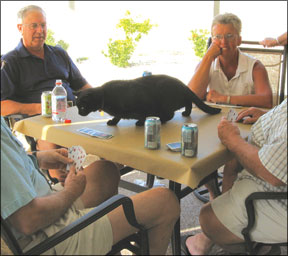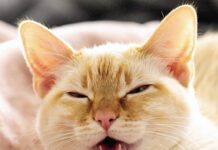Have you ever thought that your cat was hyperactive? Can a cat really suffer from hyperactivity? It seems that indoor cats are inclined to expend energy based on the schedules of their families. When people sleep, cats sleep. People move about, and cats follow. Well, maybe they follow. On a sunny day, a cat might elect to extend his nap rather than stroll along. Bev Caldwell 288 Although it is common for house cats to engage willingly when offered an opportunity to play, they are generally ready to return to rest when the computer or television set is turned on.
But it is not uncommon to encounter a cat that is just a bit busier. This would be the cat that nearly always joins in the household activity. When the shower is in use, this cat will play with the curtain. As his people wash and shave, the busy cat bats the water. And no open newspaper or computer keyboard is without a pair of paws.
Still, this more active cat does sleep at night. And when you really need to concentrate on a project, the cat reluctantly resigns himself to resting.
Just Go to Sleep Already!
What about the cat that just does not seem to nap, or at least has never been caught resting? It can be very challenging to live with He Who Never Sleeps. Therefore, it is important to determine whether an individual cat is just very active or whether the high energy reflects some underlying pathology.
Many cats are not motivated to do very much when they are alone. Lets say that you are gone for 10 hours a day. You return home a bit tired, eager to have a small meal and sit quietly, gently stroking your cat as you listen to some soothing music.
Ha, says the cat. Company at last! Lets play, lets run around hunting for lost toys, lets climb the trees. I mean the drapes. Wait, you cant go to bed yet – you just got here!
The verdict? More than likely, this is just a normal cat that has a normal amount of energy and needs some social time.
The solution? Provide some acceptable outlets. Plan a half hour of play, brushing, and petting before going on to your own agenda. Hide toys and food so that your cat can hunt while you relax. If your cat enjoys the company of other cats and you have the extra space and resources available, consider adopting a compatible cat to be a daytime playmate.
Sometimes, regardless of the hours of play or stimulation, a cat remains more than ready to go. He continues to run through the house, day and night – all night. The more you play with him, the more excited he becomes. When you try to write, your pen is batted away. You are pounced upon as you try to rest.
In many cases, cats that do not relax are suffering from anxiety. These cats may find themselves unable to settle down in the face of disturbing stimuli. Fear may actually trigger activity. Some anxious cats crave unreasonable amounts of attention and become distressed when that attention is not available on demand.
Fortunately, anxiety can be diagnosed and treated. Once the triggers have been identified, a treatment plan can be designed using environmental and behavioral modification. A medical workup may reveal that a physical ailment is causing the anxiety.
It is tempting to treat a highly active cat with a tranquilizer. Although there may be an indication for the selective occasional use of a tranquilizer, it is important to do learn the source of the excessive activity. A humane, long-term treatment plan should reduce the activity level by addressing underlying stress and anxiety.
If you believe that your cat should be resting more than he is, examine his day carefully. Design some activities for him. Provide plenty of attention by inviting him to interact with you, and avoid playing with him to appease him when he is excited. If his activity level represents a change in his behavior, have him examined by his veterinarian.



